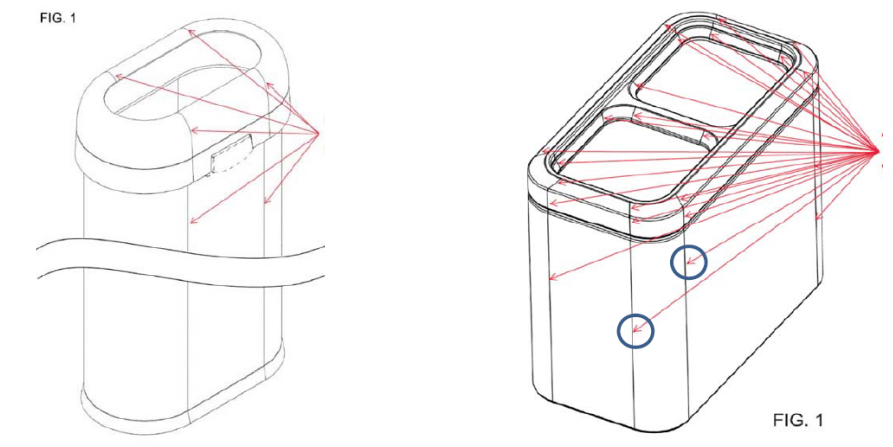Design Patent Tangent Line Risk: Litigation Lessons and Safer Drawing Techniques
- IP DaVinci
- Article
- June 6, 2025
Table of Contents
⚠️ Tangent Lines in Design Patents: An Overlooked Litigation Risk
A single overlooked line in a design patent drawing can invite costly claim interpretation disputes.
If you’re an attorney handling design patent filings—or reviewing enforceability before litigation—tangent lines deserve your attention. These faint transitions, often used to imply curvature in engineering drawings, may unknowingly broaden or narrow claim scope in ways your team never intended.
🔍 Case in Point: Simplehuman, LLC v. iTouchless Housewares
In this case, the court interpreted tangent lines in the drawings as ornamental features, not just illustrative ones. That meant the accused product had to match those subtle contour shifts to infringe—even if the overall design was functionally identical.

Outcome? The design claim’s enforceability hinged on ambiguous lines, not the intended concept.
Such cases are rare but highly instructive. One drawing element changed the litigation outcome.
🎯 Attorney Actions: Eliminate Ambiguity Before It Hurts You
Here’s what attorneys can do at the drawing stage to prevent rejection or weaken litigation posture later:
✅ 1. Understand How 3D Tools Introduce Risk
- Parametric CAD and mesh modeling software often auto-render tangent lines.
- These lines may seem helpful—but the USPTO and courts don’t treat them as optional.
- Your drawing may appear to claim subtle surface contours you didn’t intend.
✅ 2. Review All Views—Including Hidden Lines
- Tangent lines show up unexpectedly in orthographic views generated from 3D tools.
- Always inspect all views with litigation eyes: “Is this line a required feature?”
✅ 3. Specify Shading Intentionally
Instead of relying on tangent lines to show 3D form, recommend alternatives:
- Stipple Shading – Legally preferred for indicating contours without lines.
- Line Shading – May be acceptable but less ideal for subtle surfaces.
Each option creates clearer visuals and eliminates line-based ambiguity.
⚙️ Good vs. Bad: Attorney-Controlled Drawing Inputs
| Approach | Outcome |
|---|---|
| Accepting CAD output with auto-generated lines | ❌ Risk of added ornamental elements |
| Reviewing and removing unintended tangent lines | ✅ Stronger, clearer claim boundaries |
| Using stipple shading to convey 3D surfaces | ✅ USPTO-compliant, litigation-ready |
👨⚖️ Summary: From Drawing Oversight to Courtroom Consequence
Design patent claims are judged by what’s drawn—nothing more, nothing less. Tangent lines are a silent threat:
- They look harmless, but may be construed as ornamental.
- They aren’t needed, and better alternatives exist.
- They can derail enforcement if left unaddressed.
📌 Your role as an attorney isn’t just to draft claims—it’s to ensure the drawings don’t undercut them.
🚀 Want Better Drawings from the Start?
STIPPLES by IP DaVinci helps your team submit airtight, rejection-resistant drawings:
- 🧠 3D models converted into USPTO-compliant shaded views
- ✍️ Stipple or line shading applied with legal standards in mind
- ✅ Zero guesswork about view consistency or tangent line appearance
- 📁 Delivered in ready-to-file formats—fast

🔐 Lock In Stronger Claims with Better Drawings
Don't let your client's design get weakened by overlooked lines. We help you file with confidence.

